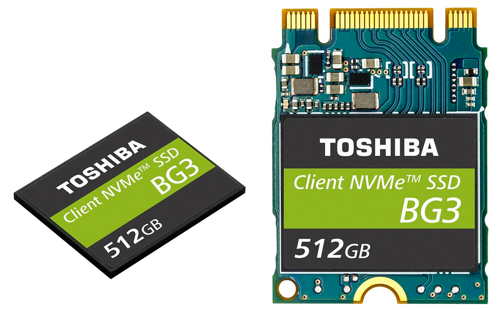Flash Memory Summit: Toshiba BG3 series SSD With 64 layer, 3-Bit-per-Cell TLC BiCS Flash
128, 256, and 512GB, single-package ball grid array SSD product line, 1.3mm high
This is a Press Release edited by StorageNewsletter.com on August 9, 2017 at 2:23 pmToshiba Electronics Europe GmbH announced the availability of the BG3 series, its next generation single-package ball grid array (BGA) SSD product line based on company’s latest 64 layer, 3-bit-per-cell TLC BiCS flash.

Designed to fuel the future of mobile devices, the company’s BG3 SSDs deliver performance [2] and a smaller footprint than traditional SATA-based drives. Moreover, with its cost-effective DRAM-less design, the BG3 series enables a quality user experience at a fraction of the power requirement of other NVMe Express [3] SSDs [4].
The BG3 series leverages the Host Memory Buffer (HMB) feature in NVMe Revision 1.2.1 to maintain high performance without integrated DRAM by using host memory for flash management purposes. This combination allows devices to harness the performance of NVMe storage while maximizing footprint and affordability to deliver a next-generation mobile experience to end users. Both fast and economical, these miniaturized SSDs also offer data center and enterprise applications an alternative solution for server boot storage.
With style and portability for laptop and tablet manufacturers, the BG3 series was designed to enable slimmer and more power efficient devices. By eliminating DRAM from its design, Toshiba’s BG3 series offers the world’s thinnest SSDs [5] available at just 1.3mm high and delivers lower power consumption to maximize battery life.
The BG3 SSDs are small in size but not performance. Featuring a PCIe (PCIe) [6] Gen3 x2 lane and NVMe Revision 1.2.1 architecture, BG3 delivers to up to 1,520 MB/s sequential read, 2.7 times the theoretical maximum bandwidth of SATA 6Gbit/s and up to 840 MB/s sequential write [7], 1.5 times the theoretical maximum bandwidth of 6Gb SATA. Additionally, BG3 also features SLC cache for performance to accelerate burst type workloads, such as those routinely experienced on Windows [8] – based PCs.
The compact BG3 series is available in 128, 256, and 512GB capacities [9]. All three models are available in a surface-mount BGA (M.2 1620) or a removable module (M.2 2230) form factor for platform design flexibility.
“Toshiba’s third generation BG SSDs are ideal for mobile and IoT computing and datacenter use alike“, says Paul Rowan, GM, SSD business unit, Toshiba Electronics Europe,. “Especially in datacenters the deployment of BG3 can greatly reduce both capital and operation expenses as the new BG3 series bridges the power and price gap between enterprise SATA and mainstream client NVMe SSDs while still providing boot storage with improved power consumption and compact footprint.“
BG3’s single-package design features a company-developed controller and firmware, integrated with the firm’s flash memory and is optimized for performance, low power, and reliability. To address modern security needs, self-encrypting drive options (SED) with TCG [10] Opal Version 2.01 are available.
The BG3 series is sampling to customers and will be demonstrated at the Flash Memory Summit 2017 in Santa Clara, CA, USA, from August 8 to 10.
[1] NVMe is a trademark of NVM Express, Inc.
[2] Faster sequential R/W transfer speeds
[3] NVM Express and the NVM Express logo are registered trademarks.
[4] Compared to M.2 2280 SSDs and M.2 1620/2230 SSDs containing DRAM
[5] 128GB and 256GB BGA models; Toshiba Memory Corporation survey, as of August 3, 2017
[6] PCIe and PCIe are registered trademarks of PCI-SIG.
[7] Toshiba Memory Corporation survey based on sequential read and write speeds of 128KB units, using 512GB models in the BG3 series under Toshiba Memory Corporation test conditions. Read and write speed may vary, depending on the host device, read and write conditions, and file size. Toshiba Memory Corporation defines a MB as 1,000,000 bytes and a KB as 210 bytes, or 1,024 bytes. The sequential read and write performance mentioned herein are reference data, and may vary with the BG3 product data in the datasheet.
[8] Windows is a registered trademark of Microsoft Corporation in the United States and/or other countries.
[9] Definition of capacity: Toshiba Memory Corporation defines a GB as 1,000,000,000 bytes. A computer OS, however, reports storage capacity using powers of 2 for the definition of 1GB = 230 bytes = 1,073,741,824 bytes, and therefore shows less storage capacity. Available storage capacity (including examples of various media files) will vary based on file size, formatting, settings, software and OS, such as Microsoft OS and/or pre-installed software applications, or media content. Actual formatted capacity may vary.
[10] Trusted Computing Group












 Subscribe to our free daily newsletter
Subscribe to our free daily newsletter
